Staying Ahead of the Curve: Using Proxies and Scraping Solutions to Monitor Pricing, Trends, and Competitors
Businesses rely on real-time data about pricing, market trends, and their rivals' activities to make well-informed decisions and maintain a competitive edge. In fact, 98%¹ of executives agree it’s somewhat or very important to increase data analysis in their companies over the upcoming 1 to 3 years. Manual data collection methods are time-consuming, less efficient, and sometimes even provide outdated data, resulting in missed opportunities and potential loss of market share.
Fortunately, thanks to technological advancements, innovative and easy-to-use solutions like proxies and web scraping tools offer businesses a powerful way to monitor and analyze vital information efficiently.
With this in-depth article, we invite you to explore the proxy and scraping landscape, discover the pros and cons of such solutions, and learn how to identify some of the best real-time data collection options in the market matching the most popular use cases. Grab a cup of coffee and continue reading.
If you can't access the whole article, make sure you have disabled your ad blocker.
Why is real-time data vital for your business growth?
Ever heard of the saying ‘data is the new oil’? As hackneyed as it might sound, it’s true. Real-time data has become a crucial catalyst for business development in the highly competitive landscape. As companies strive to make data-backed decisions, the importance of timely and relevant information cannot be overstated. Real-time data offers a wealth of advantages that directly impact a business's ability to innovate, respond to market changes, and foster that precious process called growth.
One of the most significant benefits of real-time data is its role in enhancing responsiveness. With real-time data, businesses can monitor key performance indicators (KPIs) as they advance. It empowers organizations to make agile decisions, capitalize on trends, and optimize their strategies. Whether you’re a SaaS company or an eCommerce business, timely data is the key to opening a treasure trove of opportunities.
Real-time data also allows continuous monitoring of processes and workflows, helping to identify any existing or arising bottlenecks. Businesses are able to maximize efficiency, reduce downtime, and optimize resource allocation by addressing issues in real time, all thanks to data.
Another critical aspect of data is its impact on customer experience. According to a Salesforce survey², over 66% of respondents expect that businesses will understand their needs. Data enables companies to track customer behavior, preferences, and feedback in real time. This information can be harnessed to personalize offerings, anticipate customer demands, and address issues promptly. In fact, customers will pay more³ if they know they’ll get excellent customer service. So, if you’re searching for areas of improvement, start by reviewing your customer service flow – do you provide 24/7 support? Can clients reach you via their preferred communication channels?
Additionally, real-time data plays a pivotal role in spotting emerging trends and market opportunities. Traditional data reporting methods may not capture sudden shifts or minor but important changes in consumer preferences. With real-time data analysis, businesses can identify trends as they emerge, allowing them to capitalize on new market niches or tailor their products and services to meet evolving demands.
Challenges in acquiring real-time data
With great power comes great obstacles. When individuals or businesses extract data for personal use and don’t rely on large datasets, drawbacks could be minor. However, when you’re serious about real-time information, and your growth requires big data, even a minor error could cost you a golden opportunity.
One of the primary obstacles is the sheer volume and variety of data sources available. Consolidating and processing this data meaningfully requires advanced data management and analytics capabilities, and a sheet with raw data might not give you enough context.
The speed at which real-time data is generated poses another significant challenge. Traditional data storage and processing infrastructures may struggle to keep up with the constant influx of information. As a result, there’s a risk of data overload and delays in accessing critical insights.
Data accuracy and reliability are also major concerns when dealing with real-time information. Inaccurate or incomplete data can lead to faulty decision-making, potentially causing financial losses or missed opportunities.
The need to integrate disparate data sources seamlessly could be one more challenge businesses have to overcome. Real-time data is often scattered across various platforms, making it difficult to obtain a unified view. Companies may face compatibility issues, data silos, and inconsistent formats, hindering the efficient aggregation of information.
Security and privacy concerns also loom large when acquiring real-time data. Accessing and transmitting sensitive information in real-time can expose businesses to cybersecurity risks. The challenge lies in balancing data accessibility with robust security measures.
Composing the perfect toolbox for real-time data
When it comes to collecting real-time data, there’s a plethora of choices. Businesses can pick their perfect match according to their use case and budget. However, a few more things should be considered when composing an ultimate toolbox for extracting large sets of data.
- Scalability. A scalable solution can handle the increasing data load without compromising performance. Cloud-based solutions offer the flexibility to scale resources up or down based on demand, making them ideal for handling real-time data spikes.
- Integration capabilities. Data from various sources must be integrated cohesively to gain a comprehensive view of the business landscape. An ideal toolbox should include tools that seamlessly integrate data from multiple platforms, systems, and devices.
- Real-time analytics. Data loses its significance if businesses can’t analyze it promptly. Incorporating real-time analytics tools in the toolbox enables businesses to make data-backed decisions and see a bigger picture of the industry.
- Data quality assurance. The accuracy and reliability of real-time data is paramount. Without up-to-date and error-free data, businesses won’t be able to make sound decisions.
- Security. Businesses must prioritize data security and implement robust encryption, access controls, and authentication mechanisms to protect sensitive information. According to MAGNA Media Trials and Ketch's study, 74%⁴ of respondents consider data security their number one value. Integrating security tools and practices in the toolbox fortifies data acquisition against potential cyber threats and breaches.
- Reducing latency. Employing tools that minimize data processing and transmission time is crucial for ensuring data remains relevant.
- Artificial intelligence. Leveraging machine learning and artificial intelligence technologies can bring immense value to real-time data analytics. These technologies can detect patterns and predict trends by analyzing real-time data.
Tools for collecting accurate real-time data
Once you have composed the toolbox for analyzing real-time data, there’s still one thing missing. Here’re the most popular tools that will help companies on a journey to collecting real-time data.
- Web analytics platform provides detailed insights into website traffic, user behavior, and conversion rates, enabling businesses to track website performance and optimize their online presence.
- Social media platform. With real-time monitoring capabilities, platforms allow businesses to respond to customer inquiries fast, engage with their audience, and stay on top of social media trends.
- Integration platform connects various apps and services, automating data transfers between them in real time, eliminating the need for manual data entry, and ensuring data consistency across platforms.
- eCommerce platform. A comprehensive dashboard offers up-to-the-minute insights into sales, inventory, and customer data, enabling businesses to optimize marketing strategies and offer personalized shopping experiences.
- Mobile app analytics allows real-time event tracking and user behavior analysis for mobile applications, helping enhance user experience and tailor their app's functionalities.
- Customer feedback. These instruments provide real-time customer feedback, helping companies understand their needs and preferences, and make data-driven improvements to ever-changing consumer behavior.
- Data visualization platform. Real-time data becomes more actionable when presented visually through data visualization tools. This is extremely useful for working with different teams, especially when not all members are data-savvy.
- Automated reporting solution. Such tools can generate real-time reports on various metrics, providing businesses with immediate insights into their performance and facilitating quick decision-making.
- Web scraping solution can help to collect accurate, real-time data in HTML or JSON formats that are easily applicable. According to different needs, companies can use different scraping APIs to monitor trends, pricing changes, and competitors’ developments.
With such a variety of real-time data collection tools, choosing the right one could be a true challenge. For this, we recommend using automated data collection solutions like SERP Scraping API, Web Scraping API, eCommerce Scraping API, and Social Media Scraping API.
How Do Scraping APIs work?
With Scraping APIs, you can easily gather data from various websites. You tell the API what you want, where you want to look, and how you want the information to be organized. The API takes care of things like hiding your original IP address and trying again until it delivers 100% successful results. Once collected, it presents you with the data over an open HTTP connection.
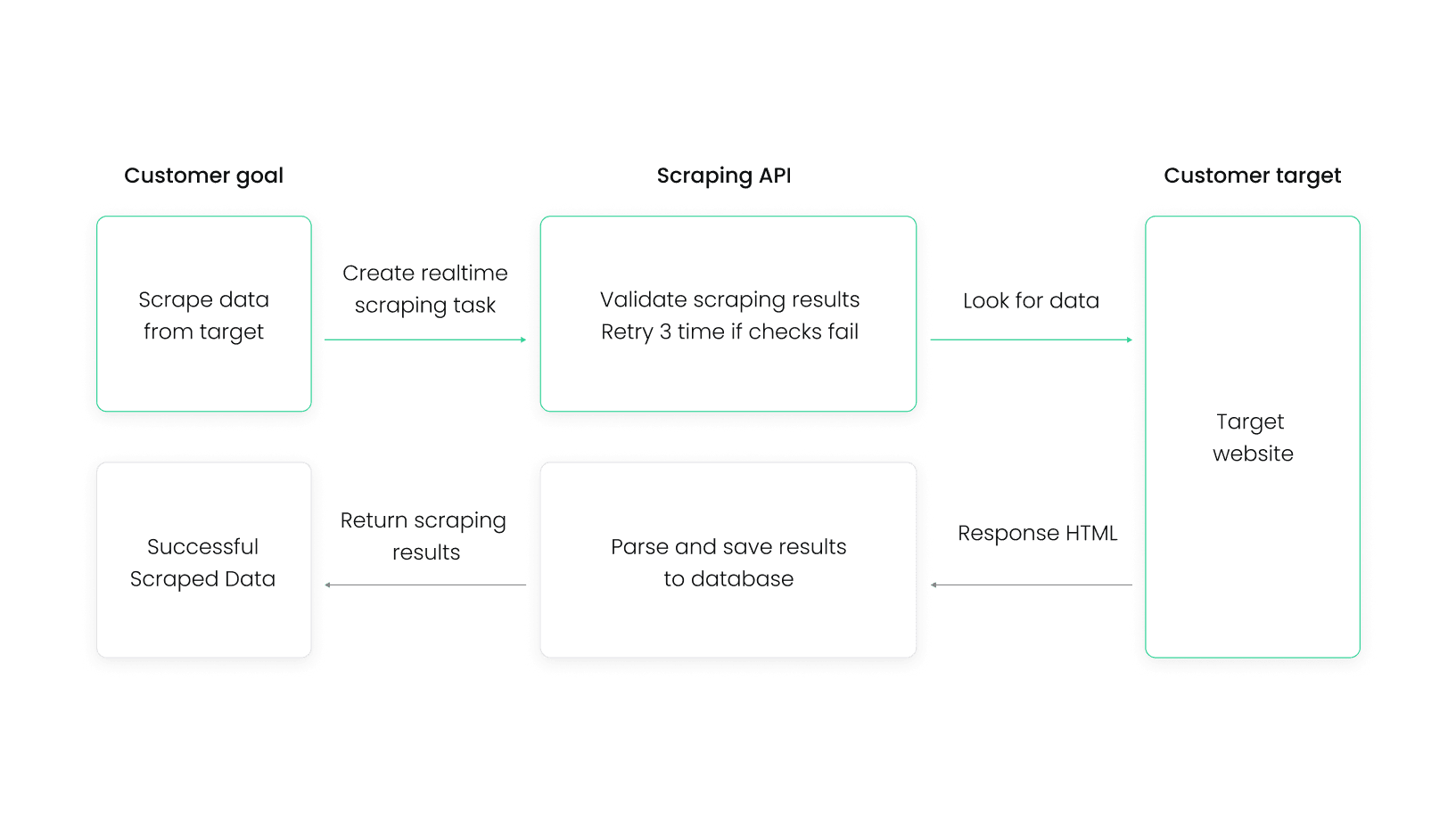
Adding one of our Scraping APIs to your toolbox is rather easy:
- Create an account or log in to your Smartproxy dashboard;
- In the right-side menu, choose the Scraping category;
- Choose the API that suits your needs and use case;
- Try SERP, Web, Social Media, or eCommerce Scraping API playground, or choose a subscription. You can also grab a free one-month trial with 3K requests!
Getting started with SERP Scraping API
SERP Scraping API allows you to extract data from Google, Baidu, Bing, and Yandex search engines by providing a URL or sending the search query as a parameter. The API returns the data in HTML format or as parsed JSON in the case of Google.
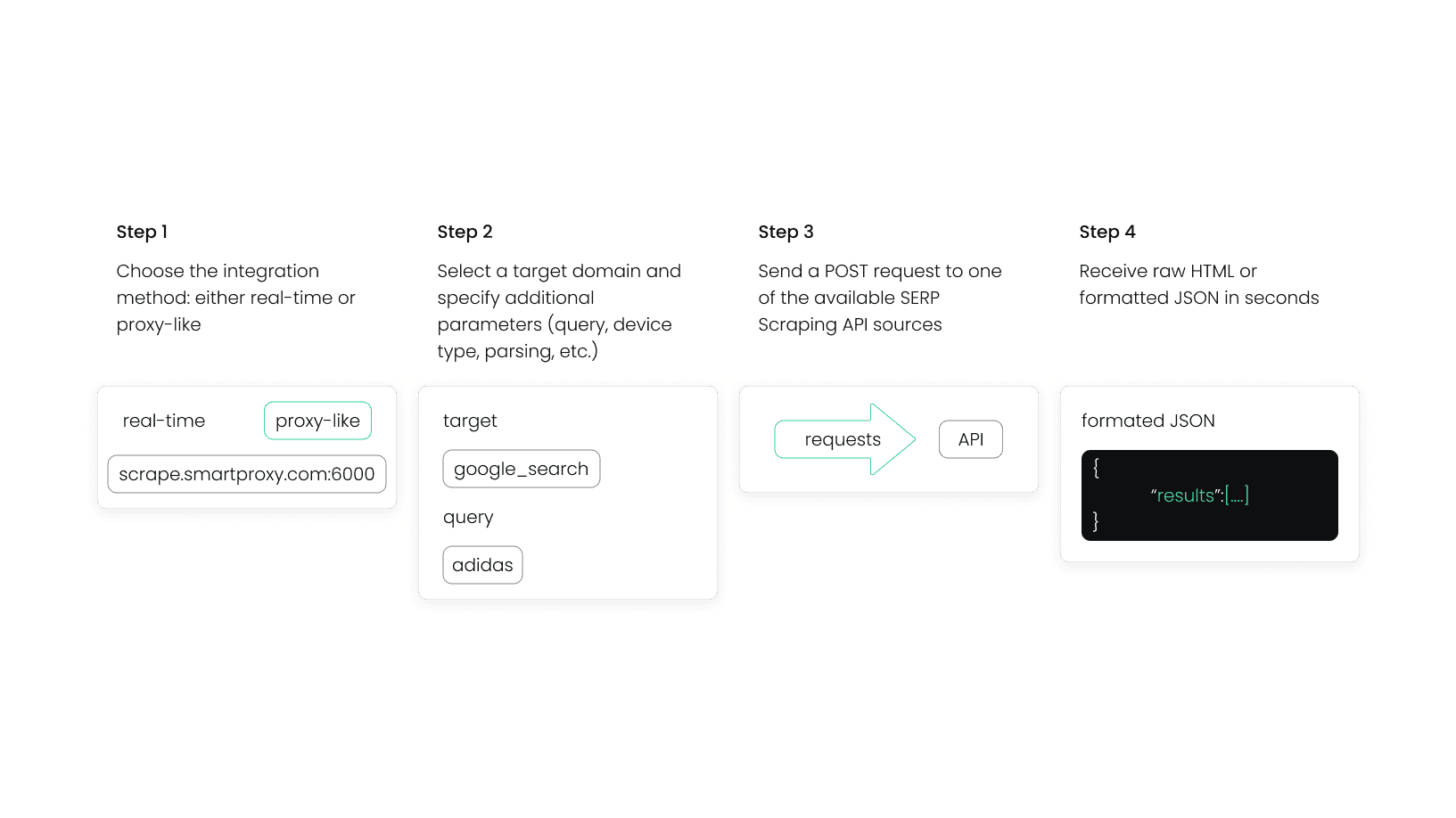
Collecting data from websites with Web Scraping API
Web Scraping API can provide the data in the HTML format. It’s an ideal solution for scenarios requiring a scalable web scraper to handle JavaScript rendering and bypass various anti-scraping protection mechanisms.
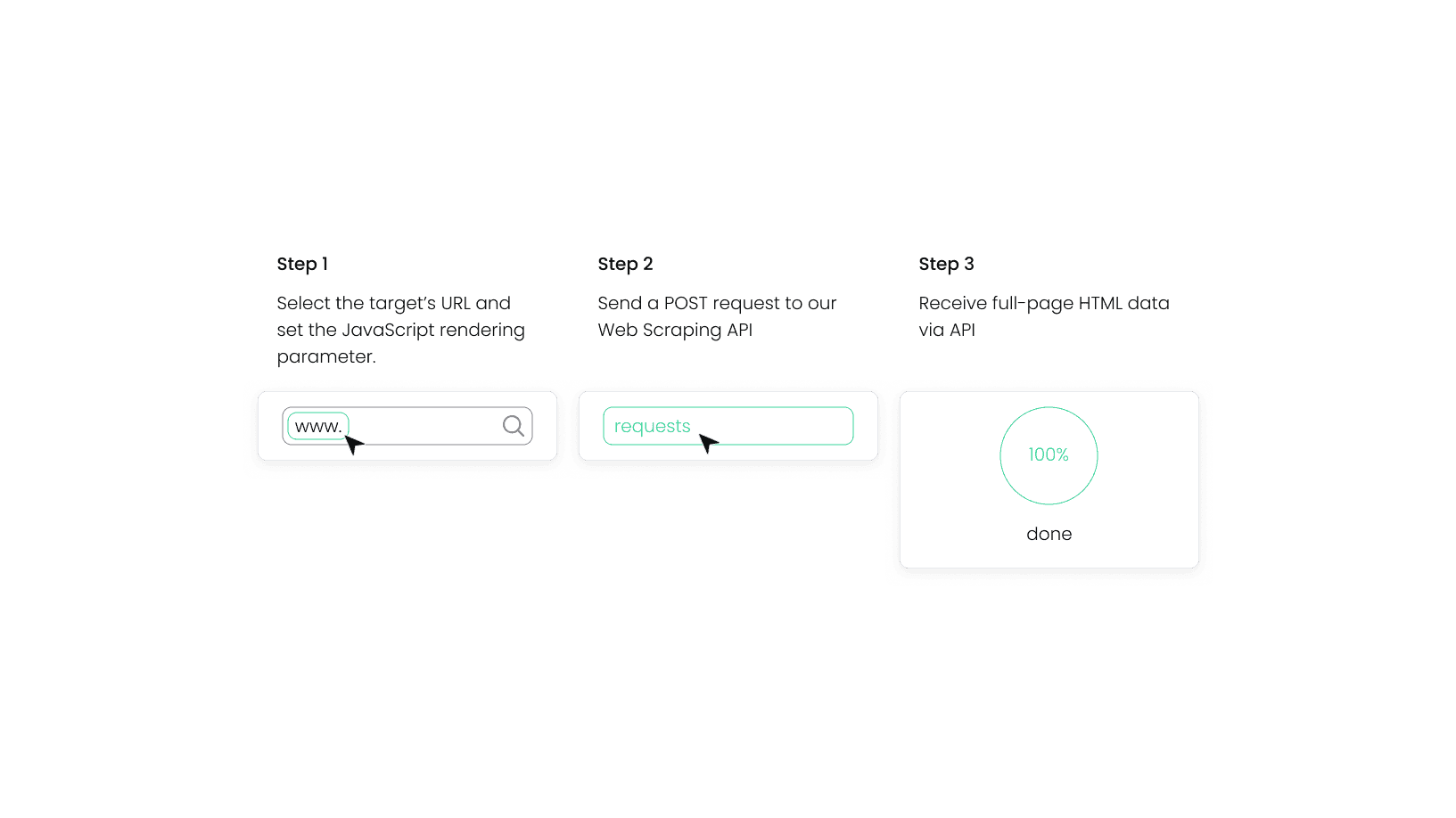
Unlocking social media data potential with Social Media Scraping API
Social Media Scraping API can help you gather structured data from social media platforms in real-time or per your request. It’s an excellent option when you want to conduct sentiment analysis, run effective influencer marketing campaigns, and complete other tasks that rely on up-to-date social media data.
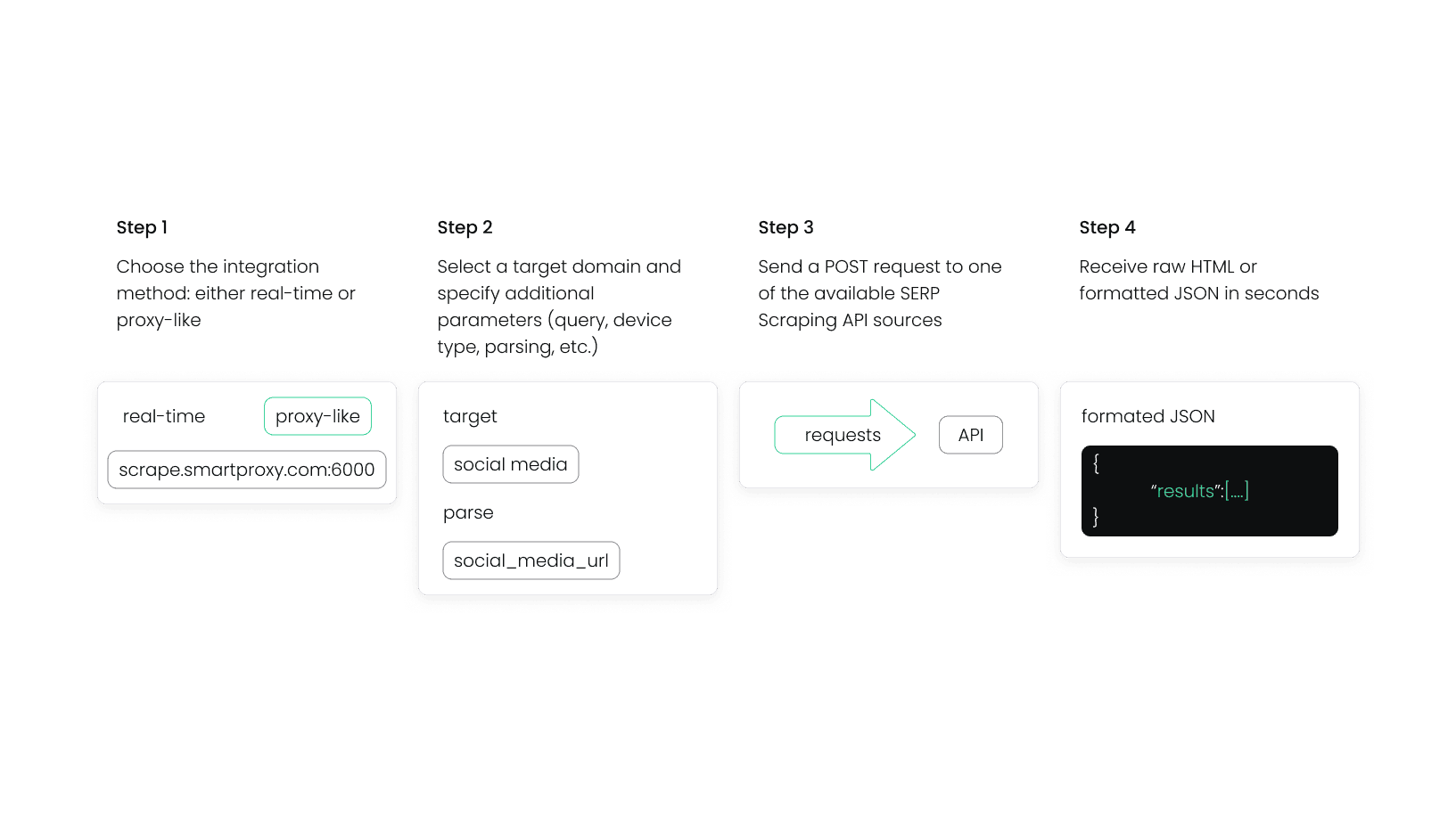
Collecting data with eCommerce Scraping API
eCommerce Scraping API allows you to extract data from various eCommerce platforms, including Amazon and Wayfair, by inputting a URL or passing the query as a parameter. It provides the data in either HTML format or, if it's from Amazon, in easy-to-digest parsed JSON format.
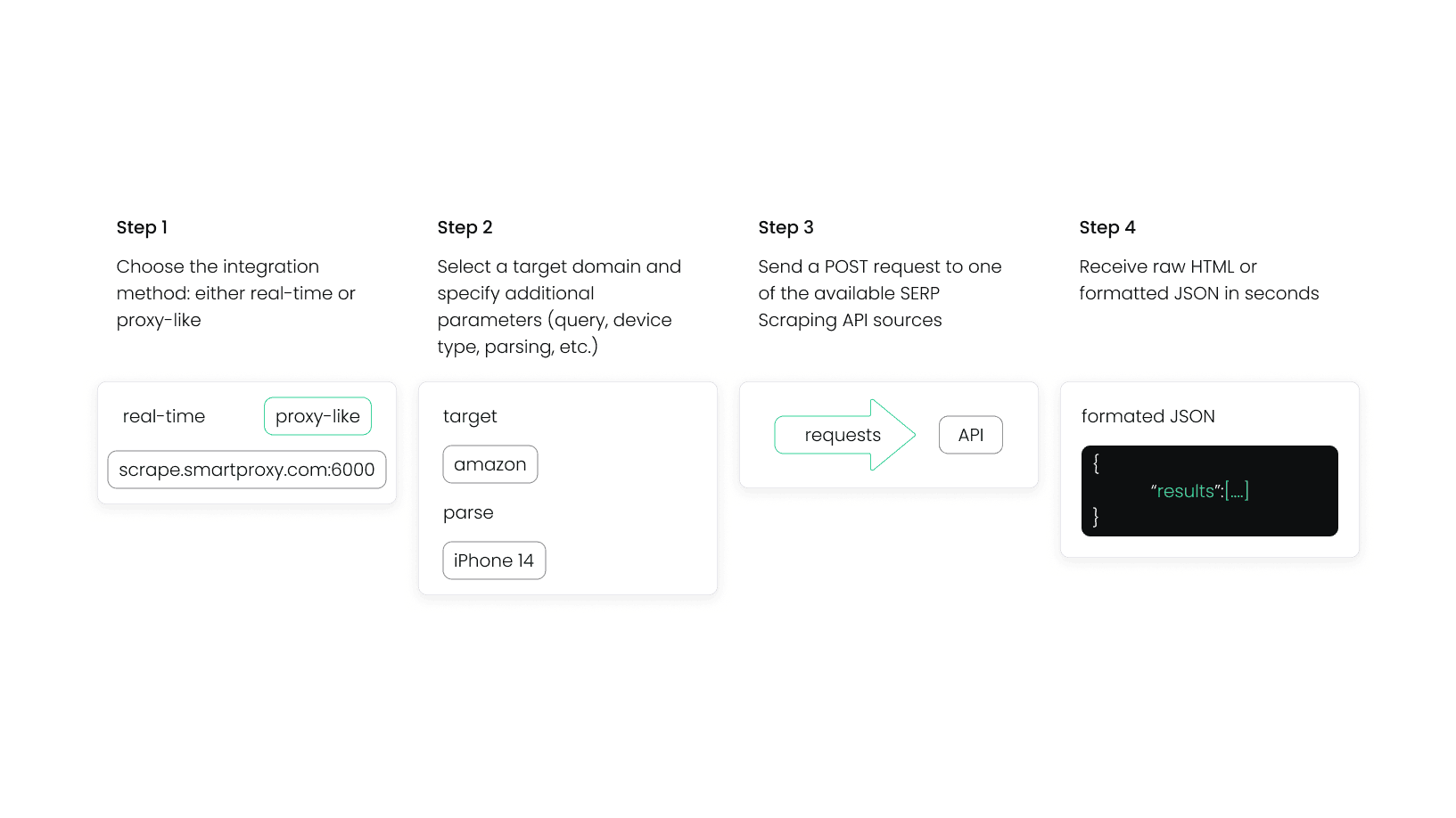
Use case #1 – price monitoring
Price monitoring is a vital practice every eCommerce company should engage in if they’re serious about their place in the competition. At the micro level, pricing data becomes valuable for retail businesses that operate in fiercely competitive markets. In such environments, where customers are sensitive to price differences and value-driven promotions, staying informed about pricing dynamics is crucial. With accurate and up-to-date pricing information, retail organizations can leverage this knowledge as a powerful product differentiator, gaining a competitive edge over their rivals.
According to the European eCommerce report, 75%⁵ of respondents have purchased goods online, believing prices are better than in brick-and-mortar stores.
By observing patterns in pricing, businesses can adjust their product offerings, marketing strategies, and customer engagement approaches to align with the changing demands of their target audience.
Use case #2 – identifying market trends
Real-time data has become a game-changer for businesses in identifying market trends. With the advent of advanced technologies and data analytics tools, companies can access and analyze a vast amount of real-time data from various sources, enabling them to gain valuable insights into consumer behavior and market dynamics.
Analysis empowers businesses to identify emerging trends early on and understand their potential impact. Whether it's the rise of a new product category like augmented reality glasses or a change in consumer sentiment – real-time insights allow for swift adaptation and innovation to meet evolving market demands.
Combining real-time data with predictive analytics empowers businesses to anticipate future market trends. Analyzing historical data alongside real-time information helps develop models and algorithms that forecast potential market movements and sudden shifts.
Use case #3 – staying ahead of your rivals
Real-time data has emerged as a game-changing resource that enables businesses to gain a strategic edge over their competitors. By harnessing it, companies can make informed decisions, ultimately positioning themselves as industry leaders.
Accurate figures and data analytics provide companies with a powerful tool to monitor their competitors' developments and identify focus areas that can give them a competitive advantage in low-competition niches within their industry.
With access to accurate data, businesses can conduct detailed competitor analysis, understanding not only their rivals' products and services but also their pricing strategies, marketing efforts, and customer engagement tactics. This information allows companies to benchmark themselves against the competition, identify gaps in their offerings, and discover untapped opportunities in the market.
Combining proxies with custom-built scraping solutions
When scraping publicly available data, no matter your use case, proxies play a crucial role in the process. They act as a virtual shield, masking the scraper's true identity and making it appear as if the data requests are coming from multiple residential sources.
Even with a custom-built scraping solution, residential proxies add an extra layer of anonymity and protection, mitigating the risk of IP blocks and ensuring uninterrupted data extraction. By rotating through a pool of proxies, businesses can avoid detection and access the desired data without arousing suspicion. This combination of custom-built scraping solutions and proxies empowers organizations to gather valuable market insights, monitor competitor activities, and make data-driven decisions with confidence and reliability.
Pro tip: use mobile proxies when scraping sophisticated targets online. These proxies have the highest success rate among all proxy types and guarantee that even the most advanced targets armed with anti-scraping software will be scraped without any restrictions posed by CAPTCHAs or IP bans.
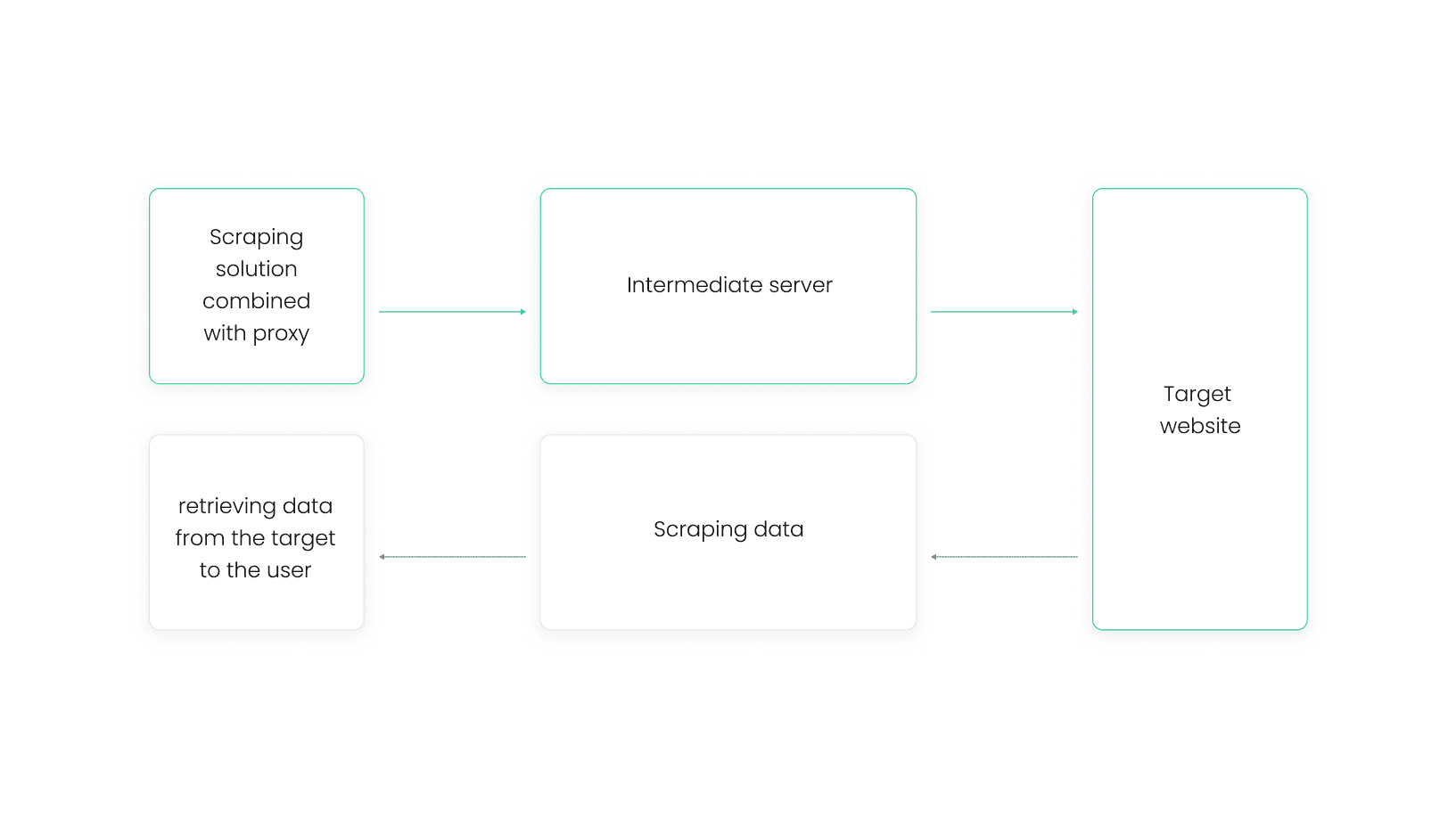
Wrapping up
Real-time data is vital in driving business growth and maintaining a competitive advantage. Companies rely heavily on up-to-date pricing insights, market trends, and competitor activities to make well-informed decisions. Traditional data collection methods are often inefficient and may provide outdated information, leading to missed opportunities and potential loss of market share.
Yet, acquiring real-time data doesn’t come without challenges. Handling the vast volume and variety of data sources, ensuring data accuracy, and integrating diverse data pose significant hurdles. Additionally, security and privacy concerns play a crucial role in data acquisition.
To assemble the ideal toolkit for real-time data collection, businesses require scalable solutions with integration capabilities, real-time usage analytics, data quality assurance, and robust security measures.
Ready to power up your scraping strategies and stay ahead of the curve? Explore all our solutions or reach out to us via LiveChat to get a solution tailored to your business needs.
Sources:
¹ https://ocient.com/tech-papers/beyond-big-data-the-rise-of-hyperscale/
² https://www.salesforce.com/resources/articles/customer-expectations/?sfdc-redirect=369
³ https://www.forbes.com/sites/shephyken/2021/08/29/customers-will-pay-more-for-this/?sh=794e99b116c6
⁴ https://content.ketch.com/consumer-privacy-perspectives-study
⁵ https://ecommerce-europe.eu/wp-content/uploads/2022/06/CMI2022_FullVersion_LIGHT_v2.pdf
About the author

Ella Moore
Ella’s here to help you untangle the anonymous world of residential proxies to make your virtual life make sense. She believes there’s nothing better than taking some time to share knowledge in this crazy fast-paced world.
All information on Smartproxy Blog is provided on an as is basis and for informational purposes only. We make no representation and disclaim all liability with respect to your use of any information contained on Smartproxy Blog or any third-party websites that may belinked therein.





